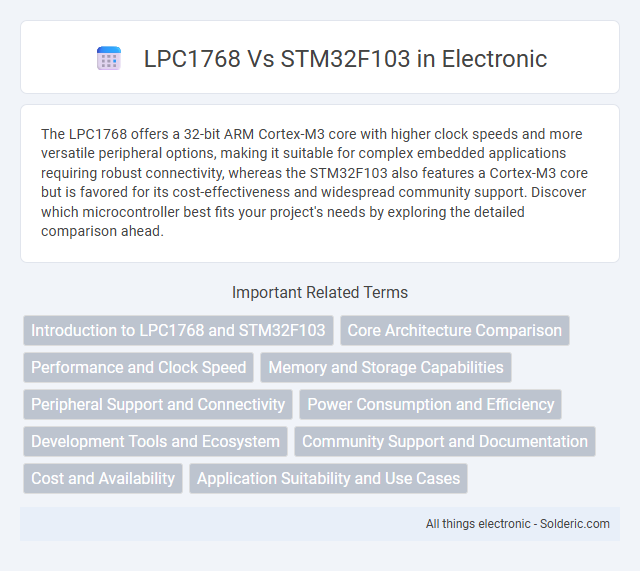The LPC1768 offers a 32-bit ARM Cortex-M3 core with higher clock speeds and more versatile peripheral options, making it suitable for complex embedded applications requiring robust connectivity, whereas the STM32F103 also features a Cortex-M3 core but is favored for its cost-effectiveness and widespread community support. Discover which microcontroller best fits your project's needs by exploring the detailed comparison ahead.
Comparison Table
| Feature | LPC1768 (NXP) | STM32F103 (STMicroelectronics) |
|---|---|---|
| CPU Core | ARM Cortex-M3 @ 100 MHz | ARM Cortex-M3 @ 72 MHz |
| Flash Memory | 512 KB | 64-128 KB |
| SRAM | 64 KB | 20-24 KB |
| Operating Voltage | 3.3 V | 2.0 - 3.6 V |
| GPIO Pins | 70+ | 37-51 (depending on package) |
| ADC Channels | 8 channels, 12-bit | 10 channels, 12-bit |
| Communication Interfaces | USART, SPI, I2C, CAN, USB 2.0 FS | USART, SPI, I2C, CAN |
| Timers | 4x 32-bit timers, PWM | 3x 16-bit timers, PWM |
| USB Support | USB 2.0 Full Speed Device/Host/OTG | USB 2.0 Full Speed Device |
| Packages | LQFP100/64 | LQFP48/64 |
| Development Ecosystem | Keil, IAR, LPCXpresso, Mbed | Keil, IAR, STM32Cube, PlatformIO |
| Use Cases | Industrial control, embedded networking, USB devices | Consumer electronics, motor control, low-power applications |
| Price Range | Higher (~$7-$10) | Lower (~$2-$4) |
Introduction to LPC1768 and STM32F103
The LPC1768 and STM32F103 are popular 32-bit microcontrollers used in embedded systems, with LPC1768 based on the ARM Cortex-M3 core from NXP and STM32F103 developed by STMicroelectronics featuring the same core architecture. Both microcontrollers offer high performance, low power consumption, and rich peripheral sets, making them ideal for applications like industrial control, consumer electronics, and IoT devices. Choosing between LPC1768 and STM32F103 depends on your specific project requirements, available development tools, and ecosystem support.
Core Architecture Comparison
The LPC1768 is powered by an ARM Cortex-M3 core operating at up to 100 MHz, offering efficient 32-bit processing and low power consumption, while the STM32F103 also utilizes the ARM Cortex-M3 core but can run at up to 72 MHz, providing a balance of speed and energy efficiency. Your choice between these microcontrollers should consider that the LPC1768's higher clock speed can enhance performance in more demanding applications, whereas the STM32F103 might offer better cost-effectiveness with sufficient processing power for many embedded projects. Both architectures support advanced features such as nested vectored interrupts and debug capabilities, ensuring robust performance across various real-time applications.
Performance and Clock Speed
The LPC1768 features an ARM Cortex-M3 core with a maximum clock speed of 100 MHz, providing efficient performance suitable for complex embedded applications. In contrast, the STM32F103 operates on an ARM Cortex-M3 core as well but typically runs at speeds up to 72 MHz, offering a balance between power consumption and processing power. Your choice between the two may depend on whether higher clock speed or lower power usage is the priority for your project.
Memory and Storage Capabilities
The LPC1768 microcontroller features 512 KB of flash memory and 64 KB of SRAM, providing ample space for complex applications and data storage. In comparison, the STM32F103 offers up to 128 KB of flash memory and 20 KB of SRAM, making it suitable for smaller, less memory-intensive projects. Your choice depends on the memory requirements of your specific embedded system design.
Peripheral Support and Connectivity
The LPC1768 features USB Full-Speed, Ethernet MAC, CAN, and multiple UART, SPI, and I2C interfaces, offering versatile peripheral connectivity for complex applications. The STM32F103 provides USB Full-Speed, CAN, multiple SPI, I2C, and UART ports but lacks integrated Ethernet, focusing more on general embedded device connectivity. Your choice depends on whether advanced networking with Ethernet support (LPC1768) or broad peripheral compatibility in cost-effective designs (STM32F103) is more critical.
Power Consumption and Efficiency
The LPC1768 microcontroller typically consumes less power in active mode compared to the STM32F103, making it more efficient for battery-powered applications. Its ARM Cortex-M3 core operates at lower voltages and supports multiple low-power modes, enhancing overall energy efficiency. Your choice will depend on balancing performance needs with power consumption constraints in your project.
Development Tools and Ecosystem
The LPC1768 benefits from robust support via Keil MDK and mbed OS, offering a rich ecosystem for rapid prototyping and real-time applications. STM32F103 is backed by the extensive STM32Cube ecosystem, including STM32CubeMX for code generation and ST's HAL libraries, providing versatile development options across various IDEs like Keil and IAR. Both microcontrollers enjoy strong community support and extensive middleware, but STM32F103's ecosystem is broader due to its larger adoption in diverse industrial and consumer products.
Community Support and Documentation
The STM32F103 benefits from a larger, more active community and extensive documentation due to its widespread adoption in various applications, making it easier for you to find tutorials, code examples, and troubleshooting help. LPC1768, while supported by a dedicated developer base and detailed official documentation from NXP, has comparatively fewer third-party resources and online forums. Choosing STM32F103 often results in faster problem resolution and richer learning materials, especially for beginners or projects requiring extensive community collaboration.
Cost and Availability
The LPC1768 microcontroller generally has a higher cost compared to the STM32F103, making the STM32F103 a more budget-friendly option for large-scale production. Availability of the STM32F103 is often superior due to widespread adoption and extensive distributor networks, ensuring consistent supply. Conversely, LPC1768 chips can sometimes face limited availability issues, affecting procurement timelines for projects requiring immediate delivery.
Application Suitability and Use Cases
The LPC1768 excels in applications requiring high-precision motor control, IoT devices, and industrial automation due to its advanced Ethernet and USB capabilities. The STM32F103 is well-suited for cost-sensitive embedded systems, consumer electronics, and low-power applications, benefiting from a robust ARM Cortex-M3 core and extensive peripheral support. Both microcontrollers serve diverse real-time control scenarios, with LPC1768 favored for connectivity-intensive tasks and STM32F103 preferred for general-purpose embedded designs.
LPC1768 vs STM32F103 Infographic

 solderic.com
solderic.com